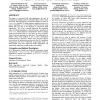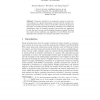2100 search results - page 50 / 420 » Learning to rank on graphs |
CAV
2009
Springer
15 years 10 months ago
2009
Springer
Abstract. Size-change termination involves deducing program termination based on the impossibility of infinite descent. To this end we may use m abstraction in which transitions ar...
WWW
2007
ACM
15 years 10 months ago
2007
ACM
This paper is concerned with rank aggregation, the task of combining the ranking results of individual rankers at meta-search. Previously, rank aggregation was performed mainly by...
WAW
2004
Springer
15 years 3 months ago
2004
Springer
d Abstract) Paolo Boldi† Massimo Santini‡ Sebastiano Vigna∗ Deciding which kind of visit accumulates high-quality pages more quickly is one of the most often debated issue i...
FAW
2008
Springer
14 years 11 months ago
2008
Springer
Abstract. Closeness centrality is an important concept in social network analysis. In a graph representing a social network, closeness centrality measures how close a vertex is to ...
EJC
2008
14 years 9 months ago
2008
A partial linear space is a non-empty set of points, provided with a collection of subsets called lines such that any pair of points is contained in at most one line and every lin...


